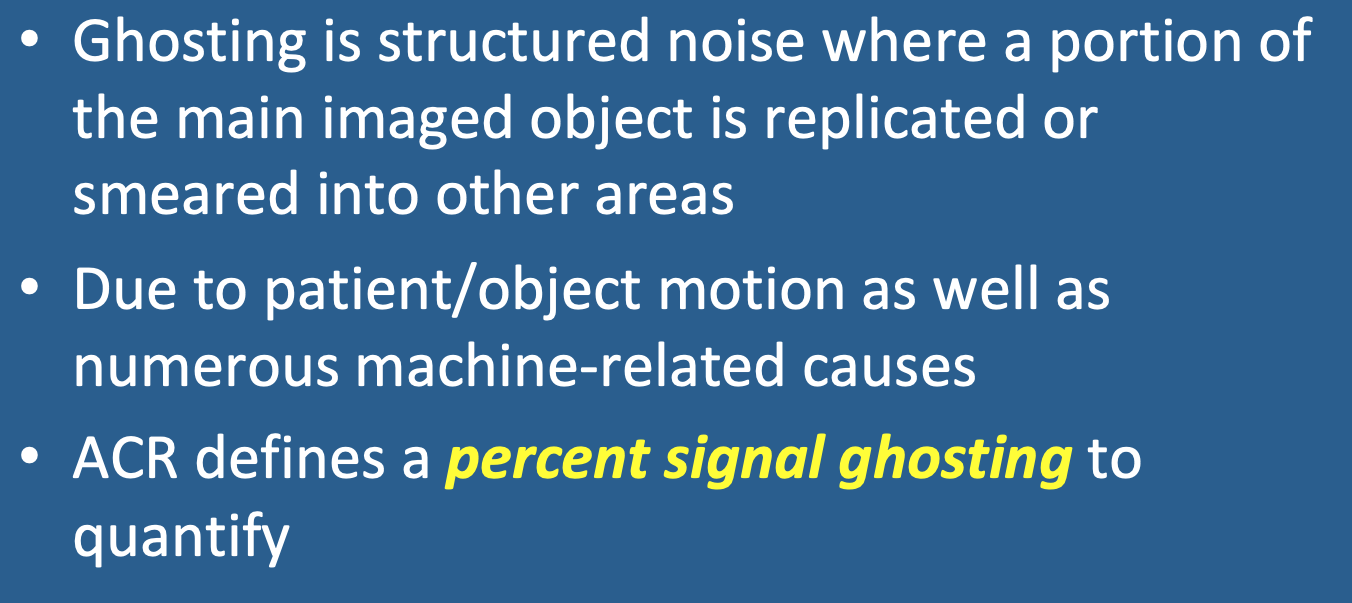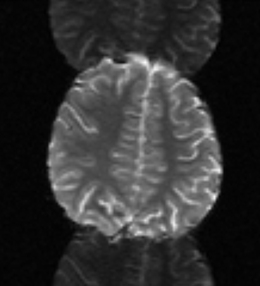|
Ghosting is a type of structured noise appearing as repeated versions of the main object (or parts thereof) in the image. They occur because of signal instability between pulse cycle repetitions. Ghosts are usually blurred, smeared, and shifted and are most commonly seen along the phase encode direction. One of the most famous of these is the so-called Nyquist N/2 ghost, described in a separate Q&A.
Ghosts most commonly arise because of physical motion during imaging (including vibration of the phantom, gross patient motion, blood flow, respiratory, and cardiac effects). For QC purposes we seek machine-related causes of ghosting which may be caused by eddy currents or a wide range of other problems in the transmit, receive, or gradient sub-systems. |
|
The American College of Radiology (ACR) recommends using a metric called "Percent Signal Ghosting" as part of routine QC. The specified regions of interest are shown in the diagram left, with S = the mean pixel intensity from the large center of the phantom. T (top), B (bottom), L (left), and R (right) are mean signals from the air outside the phantom. The ghosting ratio (G) is given by
G = | (T+B) − (L+R) | ÷ (2 x S)
The absolute value of the difference is used to insure the ratio will always be a positive number. In general the ratio should be less than 1-3%.
|
Advanced Discussion (show/hide)»
No supplementary material yet. Check back soon!
References
American Association of Physicists in Medicine (AAPM). Report No.100. Acceptance testing and quality assurance procedures for magnetic resonance imaging facilities. 2010.
American College of Radiology. Phantom test guidance for use of the large MRI phantom for the ACR accreditation program, 2018.
Reeder SB, Atalar E, Bolster Jr BD, McVeigh ER. Quantification and reduction of ghosting artifacts in interleaved echo-planar imaging. Magn Reson Med 1997; 38:429-439. [DOI link]
American Association of Physicists in Medicine (AAPM). Report No.100. Acceptance testing and quality assurance procedures for magnetic resonance imaging facilities. 2010.
American College of Radiology. Phantom test guidance for use of the large MRI phantom for the ACR accreditation program, 2018.
Reeder SB, Atalar E, Bolster Jr BD, McVeigh ER. Quantification and reduction of ghosting artifacts in interleaved echo-planar imaging. Magn Reson Med 1997; 38:429-439. [DOI link]
Related Questions
Why do motion artifacts often form into discrete ghosts?
Why are motion artifacts propagated in the phase-encode direction instead of the frequency-encode direction?
On EPI we commonly see three overlapping images. It looks somewhat like a phase wraparound artifact. What is causing this?
Why do motion artifacts often form into discrete ghosts?
Why are motion artifacts propagated in the phase-encode direction instead of the frequency-encode direction?
On EPI we commonly see three overlapping images. It looks somewhat like a phase wraparound artifact. What is causing this?


